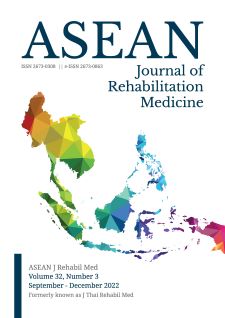Improvement of Cadres’ and Health Care Workers’ Knowledge of Diabetic Foot Care and Rehabilitation with Community-Based Rehabilitation Webinar Program in Indonesia
Keywords:
community-based rehabilitation, diabetic foot, rehabilitation, webinarAbstract
Objectives: To analyse the effect of a community-based rehabilitation (CBR) webinar program on cadres’ and health care workers’ knowledge of diabetic foot care and rehabilitation.
Study design: A quasi-experimental study.
Setting: Public Health Center of Kepulauan Seribu, Jakarta, Indonesia.
Subjects: Thirty-five Cadres and health care workers who voluntarily registered and attended a 6-session webinar program on diabetic foot care and rehabilitation.
Methods: The webinar program consisted of 3 topics: 2 sessions on early detection, 1 session on prevention, and 3 sessions on basic rehabilitative management of diabetic foot care. The participants had to complete a pre-test before each webinar session to assess their basic knowledge of each topic and a post-test to re-assess newly learned knowledge. The scores of the pre- and post-tests were then analyzed using the Wilcoxon-Signed rank test to measure the improvement of the participants’ knowledge.
Results: The pre-test scores showed that basic knowledge was highest in the early detection topic and least in the basic rehabilitative management. The post-test scores were increased significantly in most of the webinar sessions (p-value < 0.05), except in the 4th session (p-value > 0.05).
Conclusion: The 6-session CBR webinar program on diabetic foot care improved cadres’ and health care workers’ knowledge of diabetic foot care and rehabilitation. A subsequent study to evaluate the implementation of the webinar CBR program for patients with diabetic foot in Kepulauan Seribu is needed.
References
Indrahadi D, Wardana A, Pierewan A. The prevalence of diabetes mellitus and relationship with socioeconomic status in the Indonesian population. J Gizi Klinik Indones. 2021;17:103.
Badan Penelitian dan Pengembangan Kesehatan Kementrian Kesehatan RI. Laporan Nasional RISKESDAS 2018 [Internet]. Jakarta: Lembaga Penerbit Balitbangkes; 2019. [cited 2021 Nov 12]. Available from: http://labdata.litbang.kemkes.go.id/images/download/laporan/RKD/2018/Laporan_Nasional_RKD2018_FINAL.pdf
Everett E, Mathioudakis N. Update on management of diabetic foot ulcers. Ann New York Acad Sci. 2018;1411:153-65.
Khasnabis C, Heinicke Motsch K, Achu K, editors. Community-Based Rehabilitation: CBR Guidelines. Geneva: World Health Organization; 2010. Rehabilitation. [Cited 2021 Nov 15]. Available from: https://www.ncbi.nlm.nih.gov/books/NBK310933/.
Turan Y, Ertugrul BM, Lipsky BA, Bayraktar K. Does physical therapy and rehabilitation improve outcomes for diabetic foot ulcers? World J Exp Med. 2015;5:130-9.
Tran MM, Haley MN. Does exercise improve healing of diabetic foot ulcers? A systematic review. J Foot Ankle Res. 2021;14:19.
Huang Y, Chang C, Lin P, Lin B. Quantitative evaluation of rehabilitation effect on peripheral circulation of diabetic foot. IEEE J Biomed Health Inform. 2018;22:1019-25.
Francia P, Gulisano M, Anichini R, Seghieri G. Diabetic foot and exercise therapy: step by step the role of rigid posture and biomechanics treatment. Curr Diabetes Rev. 2014;10:86-99. doi:10.2174/1573399810666140507112536
S, Hossain B, Rahmawati W, Winarno SB, Dávid LD. Webinar among Indonesian academics during Covid-19, embracing the audiences. PLoS One. 2022;17:e0265257.
Sura K, Lischalk J, Leckie J, Welsh J, Mundt A, Fernandez E. Webinar-based contouring education for residents. J Am Coll Radiol. 2017;14:1074-9.e3.
Gegenfurtner A, Ebner C. Webinars in higher education and professional training: a meta-analysis and systematic review of rando-mized controlled trials. Educ Res Rev. 2019;28:100293.
Alexiadou K, Doupis J. Management of diabetic foot ulcers. Diabetes Ther. 2012;3:4.
World Health Organization, UNESCO, International Labour Organization, International Disability Development Consortium. Community-Based Rehabilitation: CBR Guidelines. Geneva: World Health Organization; 2010. p. 1-26.
Barkman, S. A field guide to designing quantitative instruments to measure program impact. Indiana: Purdue Extension; 2002. p. 19-22.
Downloads
Published
How to Cite
Issue
Section
License

This work is licensed under a Creative Commons Attribution-NonCommercial-NoDerivatives 4.0 International License.






